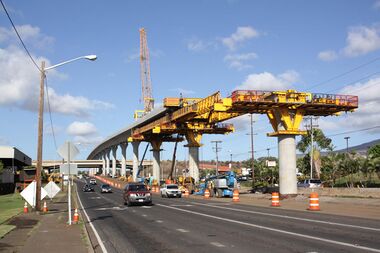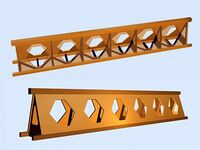Launching gantry
Topic: Engineering
 From HandWiki - Reading time: 5 min
From HandWiki - Reading time: 5 min
A launching gantry (also called beam launcher,[1] girder launcher,[2] bridge building crane,[3] and bridge-building machine, locally nicknamed the "Iron Monster"[4]) is a special-purpose mobile gantry crane used in bridge construction, specifically segmental bridges that use precast box girder bridge segments or precast girders in highway and high-speed rail bridge construction projects. The launching gantry is used to lift and support bridge segments or girders as they are placed while being supported by the bridge piers instead of the ground.
While superficially similar, launching gantry machines should not be confused with movable scaffolding systems, which also are used in segmental bridge construction. Both feature long girders spanning multiple bridge spans which move with the work, but launching gantry machines are used to lift and support precast bridge segments and bridge girders, while movable scaffolding systems are used for cast-in-place construction of bridge segments.
Operation and design
Typically, precast segmental bridges and precast girders are placed using ground-based cranes to lift each segment or girder. However, ground access to the spans may be challenged by the presence of existing infrastructure or bodies of water, or the height to which the segments must be raised can exceed the reach of ground-based cranes. A launching gantry can be used to solve these issues.[5]:38
Lua error in Module:Multiple_image at line 163: attempt to perform arithmetic on local 'totalwidth' (a nil value). The most visible feature of a launching gantry are the twin parallel girders,[5]:38 which can either be above (upper-beam) or below (lower-beam or underslung) the bridge deck.[5]:40 However, a single beam can also be used, typically in upper-beam configuration.[5]:41 The launching gantry machine usually is sized to the construction project, with the length of the twin main girders approximately 2.3 times the distance between spans. This length enables the launching gantry to span the gap between two adjacent bridge piers while providing allowances for the distance required for launching to the next span and flexibility of movement to accommodate curved paths between piers.[5]:38;40 In some cases, hinges have been inserted into the gantry girders to allow tighter curves.[6] The launching gantry girders are supported at each pier by braced frames which have a limited range of movement to facilitate placement of bridge segments or bridge girders; the launching gantry does not generally contact the bridge deck.[5]:38
Two gantry trolleys can run the full length of the launching gantry girders. Each trolley is equipped with two winches: a main winch to suspend the load, and a translation winch to move the trolley along the girders.[5]:38–39 When bridge segments (or bridge girders) are delivered at the ground level, the launching gantry is used to pick them up and raise them to deck or pier height. If the segments (or girders) are delivered instead at the bridge deck level, the launching gantry moves back to allow the forward trolley to pick up the front end of the next segment (or girder), while the back end of the segment (or girder) is supported by the transportation vehicle; as the forward trolley moves forward, the rear trolley takes over supporting the back end from the vehicle.[5]:39
Bridge segments (or bridge girders) are set in place by the launching gantry until the span between adjacent piers is completed. For segmental bridges, typically a span-by-span or balanced-cantilever approach is adopted to place segments. To free up the gantry trolley(s), temporary hangers are used to support each segment after it has been placed. In the span-by-span approach, all the segments for a span are placed before bridge tendons are tensioned; in this fashion, work progresses from one pier towards an adjacent pier. In the balanced-cantilever approach, segments are placed simultaneously on each side and work progresses from a central pier towards the two nearest piers instead. In either case, the launching gantry girders and hangers essentially serve as falsework prior to tensioning.[5]:39–40
Once the bridge span between adjacent piers is completed, the winches on the trolleys are used to lift the gantry girders and "launch" them ahead to the next span. The process of lifting and placing bridge segments (or girders) followed by launching the gantry girders ahead is repeated until the bridge is complete.[4][5]:39
An example of a large launching gantry is the SLJ900 designed in China by the Shijiazhuang Railway Design Institute and manufactured by the Beijing Wowjoint Machinery Company. This launching gantry is 91 metres (299 ft) long, 7 metres (23 ft) wide, and weighs 580 tonnes (640 short tons).[7] When driving, the machine is supported by 64 wheels, in four sections of 16 wheels each (forming two trucks, one at each end). When launching, the forward end of the machine is supported (on sliding rails) by a strut lowered onto a bridge support column, while the truck for that end hangs off the gantry backbone with no support from beneath. Once the gantry straddles the open span, the bridge segment is lowered onto the bridge support piers, and the process reverses to retract the launching gantry. The SLJ900 moves at 8 km/h (5 mph) unloaded, and 5 km/h (3 mph) carrying a bridge segment.[4]
Launching gantries are often distinguished by the design of the main girders.
Honeycomb girder
The honeycomb girder launching gantry was created in 1999 by ZZHZ, and has proven suitable to a lifting range of 5 to 300 tonnes (5.5 to 330.7 short tons).
The main girder of a honeycomb girder is fabricated from welded plates, forming an isosceles triangle cross-section. Regular hexagonal holes are cut in the inclined web plates to reduce wind resistance.[8] Because the honeycomb girder is formed by relatively long seam welds joining plates, the welds will not lose integrity easily due to small welding defects.
Truss girder
The main girder of a truss girder is fabricated from welded steel poles. The welds in a truss girder are point-to-point (joining steel poles to other poles), which requires more stringent welding technology and technique. With small self-weight and large deflection, the truss girder launching gantry is suitable for highway bridge construction projects.
Box girder
The main girder of a box girder also is fabricated from welded plates. This type of girder is usually used in high-speed railway bridge construction projects.[9]
References
- ↑ "Beam Launcher". Zhengzhou Huazhong Construction Machinery Co., Ltd.. http://www.beamlauncher.com.
- ↑ "Segment Assembled Bridge Girder Launcher". Zhengzhou Huazhong Construction Machinery Co., Ltd.. http://zzhz.com/product/bridge-girder-launcher/segment-assembled-bridge-girder-launcher-235.html.
- ↑ "Bridge Building Crane for Highway". Zhengzhou Huazhong Construction Machinery Co., Ltd.. http://cranemade.com/product/bridge-building-crane-for-highway.html.
- ↑ 4.0 4.1 4.2 Calver, Tom (20 July 2018). "The mega-machines helping China link the world". https://www.bbc.co.uk/news/world-asia-china-41206772. Article with animated diagram of functioning.
- ↑ 5.0 5.1 5.2 5.3 5.4 5.5 5.6 5.7 5.8 5.9 Rosignoli, Marco (Winter 2010). "Self-launching erection machines for precast concrete bridges". PCI Journal (Precast/Prestressed Concrete Institute): 36–57. https://www.pci.org/PCI_Docs/Design_Resources/Guides_and_manuals/references/bridge_design_manual/JL-10-Winter_Self-Launching_Erection_Machines_for_Precast_Concrete_Bridges.pdf. Retrieved 29 December 2020.
- ↑ "Hinge Launching Gantry (LG) - An innovative solution for curve bridges". NRS Bridge Construction Equipment. https://www.nrsas.com/launching-gantries/. Retrieved 29 December 2020.
- ↑ Drummond-Roe, Cecilia (4 December 2017). "Engineering feat of the month: the SLJ900/32 bridge building machine". Fircroft. https://www.fircroft.com/blogs/engineering-feat-of-the-month-the-slj90032-bridge-building-machine-71021212039. Retrieved 8 April 2018.
- ↑ "Walking Type Honeycomb Girder Launching Gantry". Zhengzhou Huazhong Construction Machinery Co., Ltd.. http://launchinggantry.com/honeycomb-girder-launching-gantry/.
- ↑ "Launching Gantry for Highspeed Railway". Zhengzhou Huazhong Construction Machinery Co., Ltd.. http://launchinggantry.com/launching-gantry-for-highspeed-railway/.
External links
- Launching gantry
- Launching gantry for high-speed rail
- Launching gantry for tunnels
- Launching gantry integrating carrying and erecting
- Launching gantry for all applications
 |
 KSF
KSF




